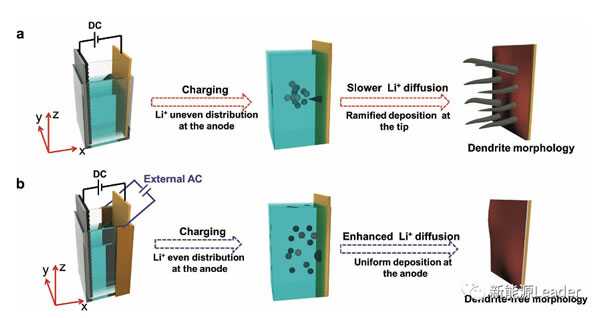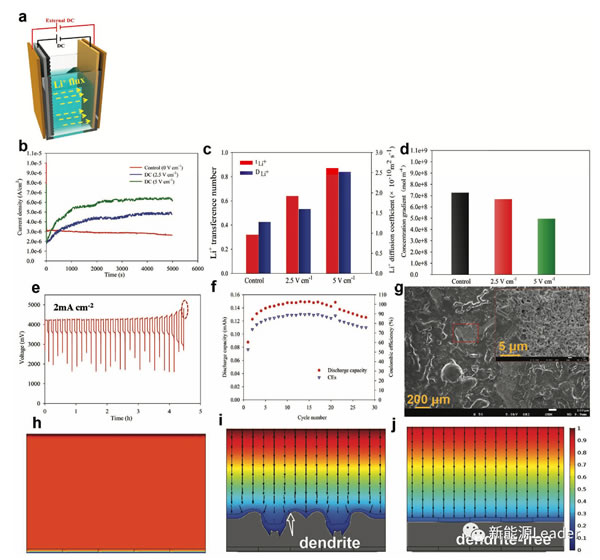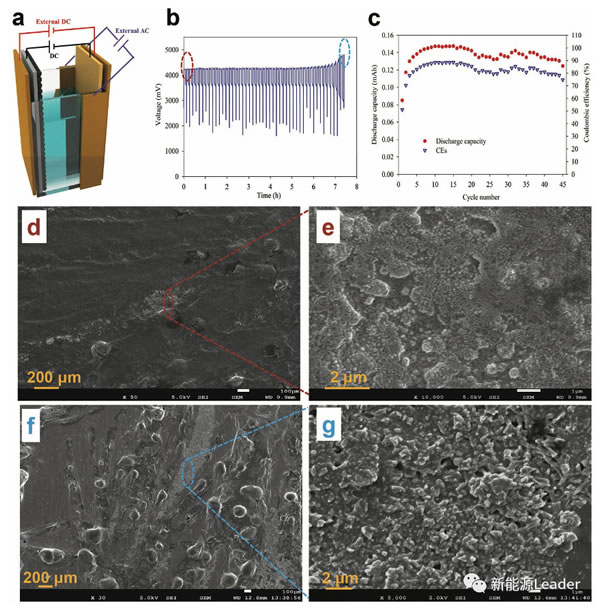In recent years, in order to meet the growing demand for high energy density of power batteries, the development of lithium metal batteries has been put on the agenda. For example, the "Battery 500" plan in the United States is to meet the high energy of 500Wh / kg through the development of lithium metal secondary batteries. The need for density. In fact, when we review the history of secondary batteries, it is not difficult to find that the qualification of metal lithium batteries is obviously earlier than that of lithium-ion batteries. It was not until the efforts of Yoshino Akira and others in the 1990s that lithium-ion batteries using graphite anodes began to grow. Large-scale commercial applications, since then, the research on metal lithium secondary batteries has also begun to gradually cool down.
The reason why the lithium metal secondary battery failed to be promoted on a large scale is mainly due to the unevenness of lithium deposition in the repeated charging process of the lithium metal negative electrode, which caused the metal lithium to become loose and porous, and the surface area was greatly increased. It will cause the volume of the metal lithium anode to continue to expand, on the other hand, it will also cause the continuous growth of the SEI film. At the same time, the extreme growth of lithium dendrites may even break through the separator and cause a short circuit in the battery, resulting in a serious safety accident. Therefore, the research work on lithium metal secondary batteries is also mainly focused on how to make the metal Li deposit more uniform, and inhibit the growth of lithium dendrites.
Studies have shown that the growth of lithium dendrites mainly stems from the mismatch between the rate of electrochemical reaction and the diffusion rate of Li +. If the rate of the electrochemical reaction is faster than the diffusion rate of Li +, a Li + concentration gradient will be generated on the surface of the lithium metal anode. It will cause uneven distribution of current, resulting in the generation and growth of dendrites. Recently, Yongxiu Chen (first author) and Yongsheng Han (corresponding author) of the Beijing Institute of Process Engineering, Chinese Academy of Sciences and others have increased the diffusion capacity of Li + by using external AC and DC electric fields, thereby suppressing the generation of Li dendrites And growth, greatly extended the service life of lithium metal secondary batteries.
AC electric field

First of all, Yongxiu Chen set two plates perpendicular to the metal lithium anode on the side of the metal lithium anode, and applied a sinusoidal alternating electric field on the plate (as shown in Figure b above). Under the action of the alternating electric field, Li's The deposition process becomes more uniform, avoiding the generation and growth of Li dendrites.
The diffusion characteristics of Li + on the surface of the metal lithium anode can be evaluated by the polarization test method. The following figure shows the test results when the author used a polarization voltage of 25mV and applied 30, 60, and 120 Hz AC electric fields on the surface of the metal lithium anode, respectively. From the figures a and b below, we can see that as the frequency of the AC electric field increases, the charge exchange impedance on the surface of the metal lithium anode decreases significantly, which is mainly due to the uniform distribution of Li + on the surface of the metal lithium anode under the action of the AC electric field. Therefore, the local Li concentration is avoided to be too low, and the reaction speed is improved.
In order to verify the role of the AC electric field in the actual battery, the author used copper foil as the negative electrode, LCO as the positive electrode, and 1M LiPF6 (EC / DEC = 1: 1) as the electrolyte to form a full battery. From the figure d below, it can be seen at 2mA The polarization voltage of the battery without AC electric field reached above 4.8V after circulating 1.62h under the current density of / cm2, while the polarization voltage of the battery protected by 30Hz AC electric field continued to be lower than 4.8V within 4.8h. Observation of the negative electrode after cycling by SEM shows that the SEI film on the surface of the negative electrode without AC electric field is damaged and a large number of dendrite structures grow. After the protection of the negative electrode surface with AC electric field, no lithium branches appear on the surface of the lithium metal negative electrode. Crystal, SEI film is basically not damaged. This indicates that the presence of an AC electric field can effectively promote the uniform distribution of Li + on the surface of the negative electrode, thereby achieving the effect of inhibiting the growth of Li dendrites.

DC electric field action
In order to further improve the diffusion rate of Li + in the electrolyte and reduce the concentration gradient on the surface of the Li anode, Yongxiu Chen also tried to add a DC electric field between the positive and negative electrodes of the battery (as shown in figure a below). From figure b below we can Seeing that the DC electric fields of 2.5V / cm and 5V / cm were increased between the positive and negative electrodes, respectively, the steady-state current of the battery increased from 0.28uA to 4.11 and 5.92uA, indicating that after increasing the DC electric field between the positive and negative electrodes The polarization of the negative electrode is significantly reduced. At the same time, we calculated that as the electric field strength between the positive and negative electrodes increases, the Li + migration number and diffusion coefficient between the positive and negative electrodes also increase significantly (as shown in figure c below), which indicates that the positive and negative electrodes The DC electric field can effectively promote the diffusion of Li + from the positive electrode to the surface of the negative electrode, so that the Li + concentration gradient on the negative electrode surface is significantly reduced (as shown in figure d below), thereby effectively inhibiting the growth of Li dendrites. The electric field strength at 5V / cm Under the circumstance, the life of the battery can be increased by 2 times (current density 2mA / cm2, as shown in e and f below).

AC-DC composite electric field action
Both DC and AC electric fields can effectively inhibit the growth of Li dendrites and improve the cycle life of lithium metal secondary batteries. Therefore, Yongxiu Chen introduced both DC and AC electric fields (DC electric field 5V / cm, AC Electric field 5V / cm, 30Hz, as shown in figure a below). From the following figures b and c, it can be seen that the life of the lithium metal secondary battery using AC and DC electric fields has increased by about 5 times compared to the control battery. Observation of the metal lithium negative electrode after 45 cycles can find that there is no dendrite on the surface of the metal lithium. Instead, the metal lithium is deposited on the surface of the negative electrode into small balls to form a smoother surface, which also ensures the SEI film. Completeness. This shows that under the combined action of AC electric field and DC electric field, on the one hand, it promotes the uniform distribution of Li + on the surface of the negative electrode, on the other hand, it also promotes the diffusion of Li + from the positive electrode to the negative electrode, thereby reducing the Li + concentration gradient on the negative electrode surface. The combined effect significantly inhibits the growth of Li dendrites, thereby greatly increasing the service life of lithium metal secondary batteries.

The generation and growth of metal Li dendrites are mainly due to the speed of the electrochemical reaction does not match the speed of Li + diffusion. Yongxiu Chen has improved the diffusion rate of Li + and the uniformity of Li + on the surface of the negative electrode by using AC and DC electric fields. , Thereby significantly reducing the polarization phenomenon on the surface of the negative electrode, inhibiting the growth of lithium dendrites, thereby effectively improving the service life of lithium metal secondary batteries, and playing a very good inspiration for the future development of lithium metal secondary batteries .
Ultra Plantâ„¢ Grow Light offers One Chip Technology aimed to meet your indoor growing expectation such as improve plants' quality, increase yield, or better the margin, etc., all for helping you realize a higher return on your crops.
Ultra Plantâ„¢ Grow Light is combined our advanced All-In-One technology with patented optical design and customized light full spectrum supported from our experienced LED engineers, plant specialists and other partners working on horticulture.
From Ultra Plantâ„¢ APP, you are able to schedule the growing process including photoperiod, brightness and spectral in advance. The lighting system will help you grow smarter, easier and better.
Ultra Plantâ„¢ is the most versatile horticultural grow lighting fixture for indoor plants with flexible full spectrum, brightness control and uniform, wider light distribution, suitable for top lighting of all types of crops. No matter it applies to anywhere for any crop, Ultra Plantâ„¢ can do perfect work for you.
730Nm Led Grow Light,730Nm Led Grow Lights,Best 730Nm Led Grow Light,730Nm Led Grow Light For Sale
Feton Corporation , https://www.nbultraplantled.com
